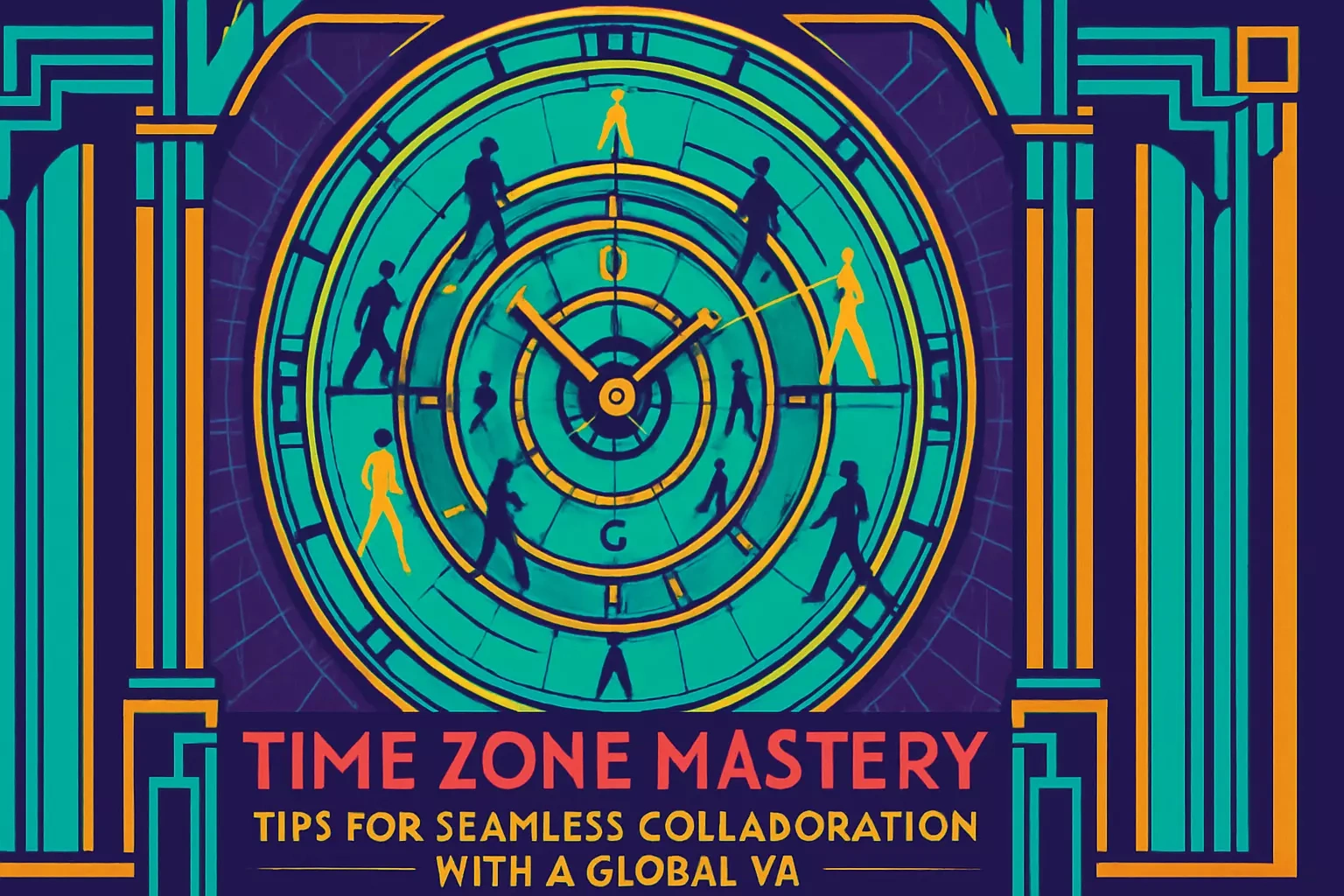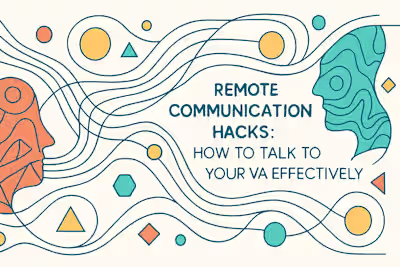Time Zone Mastery: Tips for Seamless Collaboration with a Global VA

Time Zone Mastery: Tips for Seamless Collaboration with a Global VA
Embracing an Asynchronous-First Mindset
Prioritize Detailed Documentation
Over-Communicate with Clarity
Leverage Recorded Messages and Videos
Strategic Scheduling and Tools
Use a Time Zone Converter
Identify Overlapping 'Golden Hours'
Rotate Meeting Times
Fostering a Global Team Culture
Be Mindful of Cultural Holidays and Norms
Establish Clear Work-Life Boundaries
Build Personal Connection
References
Time Zone Mastery: Tips for Seamless Collaboration with a Global VA
When you hire a virtual assistant from anywhere in the world, you gain access to a global talent pool. However, managing work across different time zones can seem challenging. With the right strategies, you can turn a potential obstacle into a 24-hour productivity cycle. This requires a shift towards asynchronous workflows, clear communication, and a foundation of trust. It's also crucial to consider the security of your data when collaborating remotely.
Working with a virtual assistant across time zones doesn't have to be complicated. In fact, it can supercharge your productivity when done right. Think about it – while you're sleeping, your VA could be completing tasks, researching, or preparing reports. You wake up to finished work, ready for review. It's like having a business that never sleeps.
The secret lies in embracing the differences rather than fighting them. Instead of seeing time zones as barriers, view them as opportunities. Your VA in Manila can handle customer inquiries while you're asleep in New York. Your London-based assistant can prepare your morning briefings while you're still dreaming in Los Angeles.
But success requires more than just good intentions. You need practical strategies, the right tools, and a mindset shift. Let's explore how to make time zone differences work in your favor.
Embracing an Asynchronous-First Mindset
The key to managing time zone differences is to move away from the expectation of real-time responses. Asynchronous communication allows work to continue around the clock, with each person contributing during their own working hours.
Think of it like a relay race. You pass the baton when your day ends, and your VA picks it up when theirs begins. No waiting around, no delays – just continuous progress.
This approach requires a fundamental shift in how you think about work. Instead of quick Slack messages and instant responses, you're building a system where everyone has what they need to work independently. It might feel strange at first, especially if you're used to walking over to someone's desk for a quick question. But once you get the hang of it, you'll wonder how you ever worked any other way.
The beauty of async work is that it forces you to be more thoughtful. You can't just fire off a vague request and expect clarification in real-time. You need to think through what you're asking for, provide context, and anticipate questions. This might seem like extra work upfront, but it saves time in the long run.
Prioritize Detailed Documentation
Create thorough documentation for workflows, processes, and tasks. This allows your VA to work autonomously without needing to wait for real-time clarification, making them more efficient.
Good documentation is like leaving a trail of breadcrumbs. Your VA should be able to follow the path without getting lost. Start with the basics – login credentials, tool access, and standard procedures. Then build from there.
Document everything that seems obvious to you. Remember, what's second nature to you might be completely new to your VA. Include screenshots, step-by-step instructions, and examples of completed work. The goal is to answer questions before they're asked.
Keep your documentation in a central location. Google Docs, Notion, or a simple shared folder work great. Make it searchable and organized. Update it regularly as processes change. Think of it as a living document that grows with your working relationship.
Over-Communicate with Clarity
In written communications, provide as much context as possible to avoid misunderstandings. When setting deadlines, always specify the time zone (e.g., "by 5 PM EST") to prevent confusion.
Here's a simple rule: if you think you've provided enough information, add one more paragraph. Explain the why behind tasks, not just the what. Share the bigger picture. Your VA will work more effectively when they understand how their work fits into your broader goals.
Be specific about expectations. Instead of "ASAP," say "by Thursday at 3 PM EST." Instead of "make it look good," provide examples of what "good" looks like to you. The clearer you are upfront, the less back-and-forth you'll need later.
Use bullet points for complex instructions. Number your steps. Bold important details. Make your messages scannable. Your VA might be reading your instructions at 2 AM their time – make it easy for them to understand even when they're not at peak alertness.
Leverage Recorded Messages and Videos
Instead of a live meeting, consider recording a short video (using tools like Loom) to explain a task. Your VA can watch it on their own time and refer back to it as needed.
Video messages add a personal touch that text can't match. They're perfect for complex tasks that are hard to explain in writing. Show your screen, walk through the process, and let your VA see exactly what you're looking for.
Keep videos short and focused. Five minutes or less is ideal. If you need more time, break it into multiple videos. Label them clearly so your VA can find what they need quickly.
The best part? Your VA can pause, rewind, and rewatch as needed. They can take notes without missing anything. And you only have to explain it once. It's a win-win that saves everyone time.
Strategic Scheduling and Tools
While most work can be asynchronous, some real-time collaboration is necessary. Strategic scheduling and the right tools can make this process painless.
The trick is to be intentional about when and why you meet in real-time. Not every conversation needs to be a meeting. Save synchronous time for what truly requires it – brainstorming, relationship building, and complex problem-solving.
Technology is your friend here. The right tools can bridge the gap between time zones, making collaboration feel seamless even when you're continents apart. But don't go overboard. Choose a few key tools and use them well rather than juggling dozens of apps.
Remember, the goal isn't to eliminate all real-time interaction. It's to make that interaction count. When you do meet, make it worthwhile for everyone involved.
Use a Time Zone Converter
A simple but essential tool. Before scheduling any meeting, use a time zone converter to find a time that is reasonable for everyone involved. Many calendar apps have this feature built-in.
World Clock Meeting Planner, Time.is, or even a simple Google search can save you from scheduling headaches. Make it a habit to double-check times before sending invites. Nothing damages trust faster than repeatedly scheduling meetings at 3 AM someone's time.
Consider adding multiple time zones to your calendar view. Most calendar apps let you display several time zones side by side. This visual reminder helps you stay mindful of your VA's working hours.
Pro tip: Include the time in multiple zones when sending meeting invites. Write "Meeting at 2 PM EST / 7 PM GMT / 3 AM JST+1" so everyone knows exactly when to show up. It takes an extra second but prevents costly mix-ups.
Identify Overlapping 'Golden Hours'
Find the few hours where your workdays overlap. Protect this time and reserve it for high-priority synchronous activities like brainstorming sessions, important check-ins, or feedback discussions.
These golden hours are precious. Don't waste them on tasks that could be handled asynchronously. Use them for conversations that benefit from real-time back-and-forth.
Map out your overlapping hours visually. Create a simple chart showing when you're both available. This might be just 2-3 hours, and that's okay. Quality matters more than quantity.
Block these hours in your calendar. Treat them as sacred time for collaboration. Let your VA know these are your preferred meeting times. This predictability helps both of you plan your days better.
Rotate Meeting Times
To be fair, rotate meeting times so the same person isn't always required to join early in the morning or late at night. This shows respect for your VA's work-life balance.
If your golden hours fall at an inconvenient time for your VA, alternate who takes the hit. One week, you might meet at 7 AM your time. The next week, you stay late for an 8 PM call. Sharing the burden builds goodwill and shows you value their time.
Keep track of who's accommodating whom. A simple spreadsheet works fine. Note when meetings fall outside normal hours for each person. Aim for balance over time.
When you do ask your VA to meet outside their preferred hours, acknowledge it. A simple "I know this is early for you, thanks for making time" goes a long way. Small gestures of appreciation matter, especially across distances.
Fostering a Global Team Culture
Working effectively with a global VA goes beyond logistics. It's about building a culture of respect and understanding that acknowledges and values different backgrounds.
Culture isn't just about holidays and customs. It's about creating an environment where your VA feels valued, heard, and part of something bigger. This takes intentional effort, especially when you can't share coffee breaks or casual office chatter.
The distance can actually be an advantage. It forces you to be more deliberate about building relationships. You can't rely on proximity to create connection. Instead, you build it through consistent actions, clear communication, and genuine interest in your VA as a person.
Remember, your VA chose to work remotely across time zones. They're likely adaptable, independent, and skilled at managing their time. Respect these qualities and build on them.
Be Mindful of Cultural Holidays and Norms
Be aware of the public holidays in your VA's country and respect them. Understanding cultural communication nuances can also help prevent misunderstandings and build a stronger relationship.
Add your VA's national holidays to your calendar. Ask about important cultural or religious observances they celebrate. Show interest in their traditions. This awareness prevents you from assigning urgent tasks during their important celebrations.
Communication styles vary by culture. Some cultures are more direct, others more diplomatic. Some value hierarchy, others prefer informal interaction. Pay attention to these differences and adapt your style accordingly.
Learn a few phrases in your VA's language. Even a simple "good morning" or "thank you" in their native tongue shows effort and respect. It's a small gesture that makes a big impact.
Establish Clear Work-Life Boundaries
Encourage your VA to set clear start and end times for their workday. Respect these "blackout hours" and avoid contacting them outside of their agreed-upon schedule.
Just because you can reach your VA 24/7 doesn't mean you should. Establish clear working hours from the start. Put them in writing. Stick to them except for true emergencies.
Use scheduled messages when you think of something outside their hours. Most communication tools let you write now and send later. This way, you can work when inspiration strikes without disrupting your VA's personal time.
Lead by example. If you respect boundaries, your VA will feel comfortable setting and maintaining their own. This mutual respect creates a healthier, more sustainable working relationship.
Build Personal Connection
Take time during your overlapping hours for informal chats. Building a personal rapport helps bridge the geographical distance and strengthens the professional relationship.
Start meetings with a few minutes of casual conversation. Ask about their weekend, their family, their interests. Share a bit about your own life too. These small exchanges build trust over time.
Celebrate wins together. When your VA completes a big project or reaches a milestone, acknowledge it. A simple congratulations message or a small bonus shows you notice and appreciate their efforts.
Consider virtual coffee chats with no agenda. Once a month, hop on a call just to connect as humans. Talk about anything but work. These informal moments often strengthen the professional relationship more than any formal meeting could.
Working across time zones with a global VA isn't just manageable – it's an opportunity to build a more flexible, productive, and enriching work relationship. The key is to embrace the asynchronous mindset, use the right tools strategically, and build a culture of mutual respect and understanding.
Start small. Pick one or two strategies from this guide and implement them this week. Maybe it's creating your first process document or scheduling a casual chat with your VA. Small steps lead to big improvements over time.
Remember, perfection isn't the goal. You'll make mistakes, miscommunicate sometimes, and occasionally schedule meetings at awkward hours. That's okay. What matters is the commitment to continuous improvement and treating your VA as the valuable team member they are.
The world is your talent pool. Time zones are just numbers on a clock. With the right approach, you can build a thriving partnership that transcends geographical boundaries and creates value around the clock. Your global VA is waiting – it's time to make those time zones work for you, not against you.
References
Like this project
Posted Jun 30, 2025
Working with a virtual assistant in another time zone? Turn it into a strategic advantage with these tips for mastering asynchronous work and communication.









